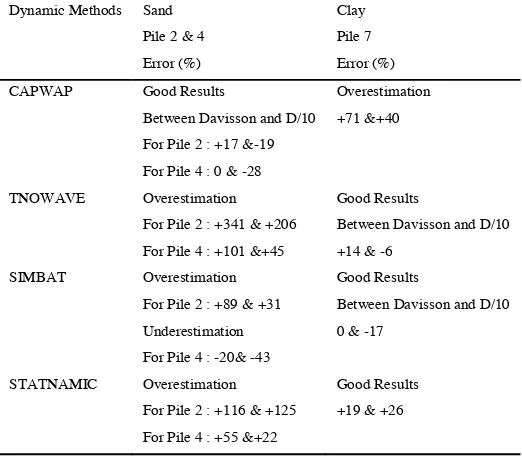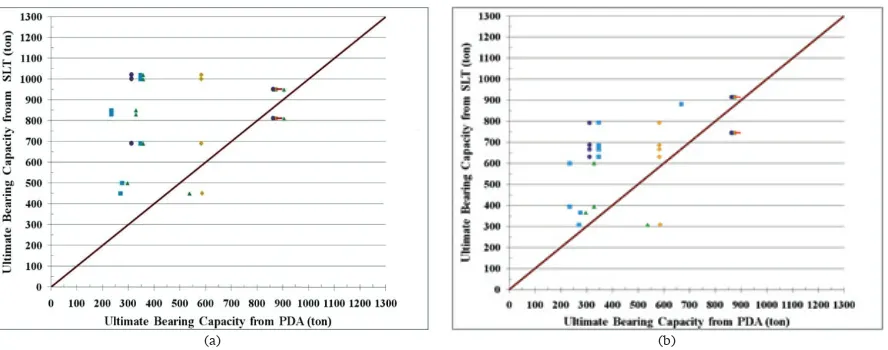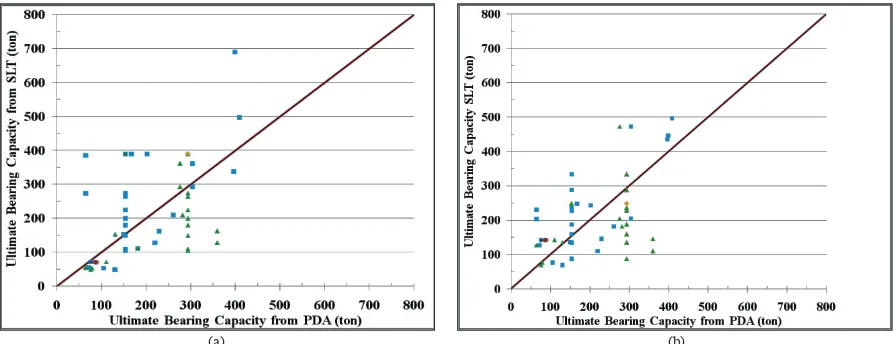Procedia Engineering 125 ( 2015 ) 406 – 410
1877-7058 © 2015 The Authors. Published by Elsevier Ltd. This is an open access article under the CC BY-NC-ND license (http://creativecommons.org/licenses/by-nc-nd/4.0/).
Peer-review under responsibility of organizing committee of The 5th International Conference of Euro Asia Civil Engineering Forum (EACEF-5) doi: 10.1016/j.proeng.2015.11.101
ScienceDirect
The 5th International Conference of Euro Asia Civil Engineering Forum (EACEF-5)
Bearing capacity of pile foundations embedded in clays and sands
layer predicted using PDA test and static load test
Gogot Setyo Budi
a,*, Melisa Kosasi
b, Dewi Hindra Wijaya
caCivil Engineering depatment of Petra Christian University, Siwalankerto 121-131, Surabaya 60236, Indonesia b
Data Persada, Margorejo Indah XIX/35, Surabaya 60238, Indonesia
c
Teno Indonesia, Raya Kertajaya Indah 153, Surabaya 60116, Indonesia
Abstract
Static Load Test (SLT) is the realiable method to determine bearing capacity of pile foundations. However, SLT is relatively expensive and time consuming compared to Pile Driving Analyzer (PDA) test. Therefore PDA test becoming more populer as an alternative to predict bearing capacity of piles. This paper presents the comparation of ultimate bearing capacity of pile foundations interpreted from Static Load Test (SLT) results and that predicted from PDA tests. Davisson and Chin methods were used to determine bearing capacity of pile foundations interpreted from SLT results. Correlation between bearing capacity of piles embedded in sand and clay layer interpreted from SLT and PDA test was analyzed.
The result shows that bearing capacity of piles which determined based on Static Load Test interpreted using Davisson and Chin methods exhibit relatively better agreement with the predetermined ultimate bearing capacity. Almost all records of bearing capacity of pile foundation embedded in sands layer interpreted from SLT are larger than those predicted using PDA test. While bearing capacity of piles embedded in clays predicted using PDA test varies in relatively large margin compared to that determined from SLT.
© 2015 The Authors. Published by Elsevier Ltd.
Peer-review under responsibility of organizing committee of The 5th International Conference of Euro Asia Civil Engineering Forum (EACEF-5).
Keywords: Static Load Test; Pile driving analyzer; Pile foundations.
* Corresponding author. Tel.: +62-312983397; fax: +62-318436418.
E-mail address: [email protected]
© 2015 The Authors. Published by Elsevier Ltd. This is an open access article under the CC BY-NC-ND license (http://creativecommons.org/licenses/by-nc-nd/4.0/).
1.Introduction
Static Load test (SLT) and Pile Driving Analyzer (PDA) tests on pile foundations have been conducted to several projects in Indonesia to determine its bearing capacity. SLT and PDA tests were performed on forty one (41) pile foundations in eleven different areas that located in Java and Sumatra islands. The piles consist of precast concrete and bored piles with dimensions ranging from 25 cm to 120 cm. Out of 41 tested piles, 13 pairs of piles (13 piles were tested using SLT and 13 piles were tested using PDA test) were embedded in sand layer and 28 pairs of piles were installed in clay layer.
All records of PDA tests were collected from restrike condition since the tests were performed after the piles had been installed. The dynamic test was performed using PDA type PAX that manufactured by Pile Dynamic, Inc. USA. The bearing capacity prediction resulted from PDA tests was analyzed using CAPWAP (Case Pile Wave Analysis Program).
The objective of the research is to study the accuracy of bearing capacity of piles foundation predicted using PDA test compared to that determined from Static Load Test. In addition, the effect of soil type on the bearing capacity of piles predicted using PDA is also presented
2.Previous study
In his paper, Svinkin [1] presented his evaluation of bearing capacity of a pile embedded in clay and two piles in sand layer that predicted using dynamic analysis such as CAPWAP, TNOWAVE, SIMBAT, and STATNAMIC. The results, which presented in Table 1, show that CAPWAP analysis on bearing capacity of two piles embedded in sand layer categorized as Good Results, while the bearing capacity of a pile embedded in clay layer considered as
Overestimate.
Table 1. Evaluation of static bearing capacity of piles embedded in sands and clays determined using dynamic testing method.
In their publication, Shaarawi et al. [6] concluded that Chin, Mazurkiewicz, and Decourt methods provide a good interpretation of bearing capacity of pile foundations. Meanwhile, Hasnat et al. [7] stated that the Davisson method provides high accuracy and narrow margin of distribution of bearing capacity of the pile foundations.
Research methodology
All data were collected from the piling company in Surabaya ‒ Indonesia, which provides not only piling
services, but also testing services such as Static Load Test (SLT), Pile Driving Analyzer (PDA), Pile Integrity Test (PIT), etc. There were numerous data of SLT and PDA available in each project, however almost all data of SLT and PDA were not obtained from the same piles. Therefore, the comparison of the bearing capacity of piles interpreted from SLT and analyzed from PDA in this analysis based on data of different piles in the same project.
Besides, only SLT data that exhibits non-elastic relationship between load and settlement were used in the analysis. In other words, data of SLT that remain elastic during loading and unloading, which presented by nearly-zero permanent settlement during unloading, excluded from the analysis.
3.Results
The relationship of ultimate bearing capacity of the piles determined using Davisson, Chin, Mazurkiewics, and Decourt methods and designed bearing capacity is presented in Fig. 1(a), Fig. 1(b), Fig. 1(c), and Fig. 1(d). It shows that, in general, the ultimate bearing capacity which interpreted using Davisson and Chin methods exhibits a better agreement with ultimate design load of the piles compared to that analysed by the other two methods.
In this paper, only Davisson and Chin methods were used to determine ultimate bearing capacity of the piles interpreted from the SLT results.
(a) (b)
(c) (d)
Ultimate bearing capacity of 41 tested pile foundations determined using Davisson and Chin methods were compared to the ultimate bearing capacity analysed using PDA tests. Fig. 2 shows the distribution of ultimate bearing capacity of pile foundations interpreted from SLT plotted against that predicted from PDA tests. The relationship of bearing capacity of tested piles that interpreted using Chin method (Fig. 2(b)) and PDA test exhibits relatively narrow margin compared to that interpreted using Davisson method (Fig. 2(a))
(a) (b)
Fig 2. Relationship of bearing capacity of piles resulted from SLT and PDA test. (a) Interpreted from SLT using Davisson method; (b) Interpreted from SLT using Chin method.
Out of 41 tested piles, 13 pairs of piles were embedded in sand layer while 28 pairs of piles were installed in clay layer. The effect of soil layers to the bearing capacity of pile foundations interpreted from SLT and predicted from PDA tests is presented in Fig. 3 and Fig. 4. The ultimate bearing capacity of almost all tested piles embedded in sand layer, which predicted using PDA tests, are smaller than those determined based on SLT results, as presented in Fig. 3. However, there is no clear trend of relationship of bearing capacity of piles embedded in clays, which determined from SLT data and PDA tests results as shown in Fig. 4.
(a) (b)
(a) (b)
Fig. 4. Relationship of bearing capacity of piles embedded in clay layer resulted from SLT and PDA test. (a) Interpreted from SLT using Davisson method; (b) Interpreted from SLT using Chin method.
4.Conclusions
Bearing capacity of piles that determined based on Static Load Test varies significantly; depend on the method used to interpret the data. However, Davisson and Chin methods exhibit relatively better agreement with the designed ultimate bearing capacity.
The ultimate bearing capacity of the piles embedded in clays layer that predicted using PDA test varies significantly high compared to that determined from SLT results. While the ultimate bearing capacity of the piles embedded in sands layer that predicted by PDA test is smaller compared to that determined from SLT results.
Acknowledgements
The authors would like to express their gratitude and appreciation to PT Teno Indonesia that provided data of SLT and PDA tests and its related information.
References
[1] M. Svinkin, Engineering Evaluation of Static Pile Capacity by Dynamic Methods.
http://www.academia.edu/7719889/Engineering_evaluation_of_static_pile_capacity_by_dynamic_methods (2011), pp 182
[2] M. T. Davisson, High Capacity Piles, In Innovations in Foundation Construction, Soil Mechanics Division, Illinois, ASCE, Chicago, USA, 1972, pp. 81-112.
[3] Y. K.Chin, S. L. Tan and S. B. Tan, Ultimate Load Tests on Instrumented Bored Piles in Singapore Old Alluvium, Eight Southeast Asian Geotechnical Conference, Kuala Lumpur, 1985.
[4] Mazurkiewicz, B.K., Test Loading of Piles According to Polish Regulations, Preliminary Report No. 35, Commission on Pile Research, Royal Swedish Academy of Engineering Services, Stockholm, 1972.
[5] Decourt L. Behaviour of Foundation under Working Load Condition. Proceedings of the Pan- American Conference on Soil Mechanics and Geotechnical Engineering, Foz Dolguassu, Brazil,vol 4, (1999), pp. 453-488.
[6] E. Shaarawi, G. Abdelrahman, & K. Abouzaid, Interpretation of Axial Pile Load Test Result for Continuous Flight Auger Piles, Proceedings of 9th Arab Structural Engineering Conference, Abu Dhabi, UAE, 2003.



